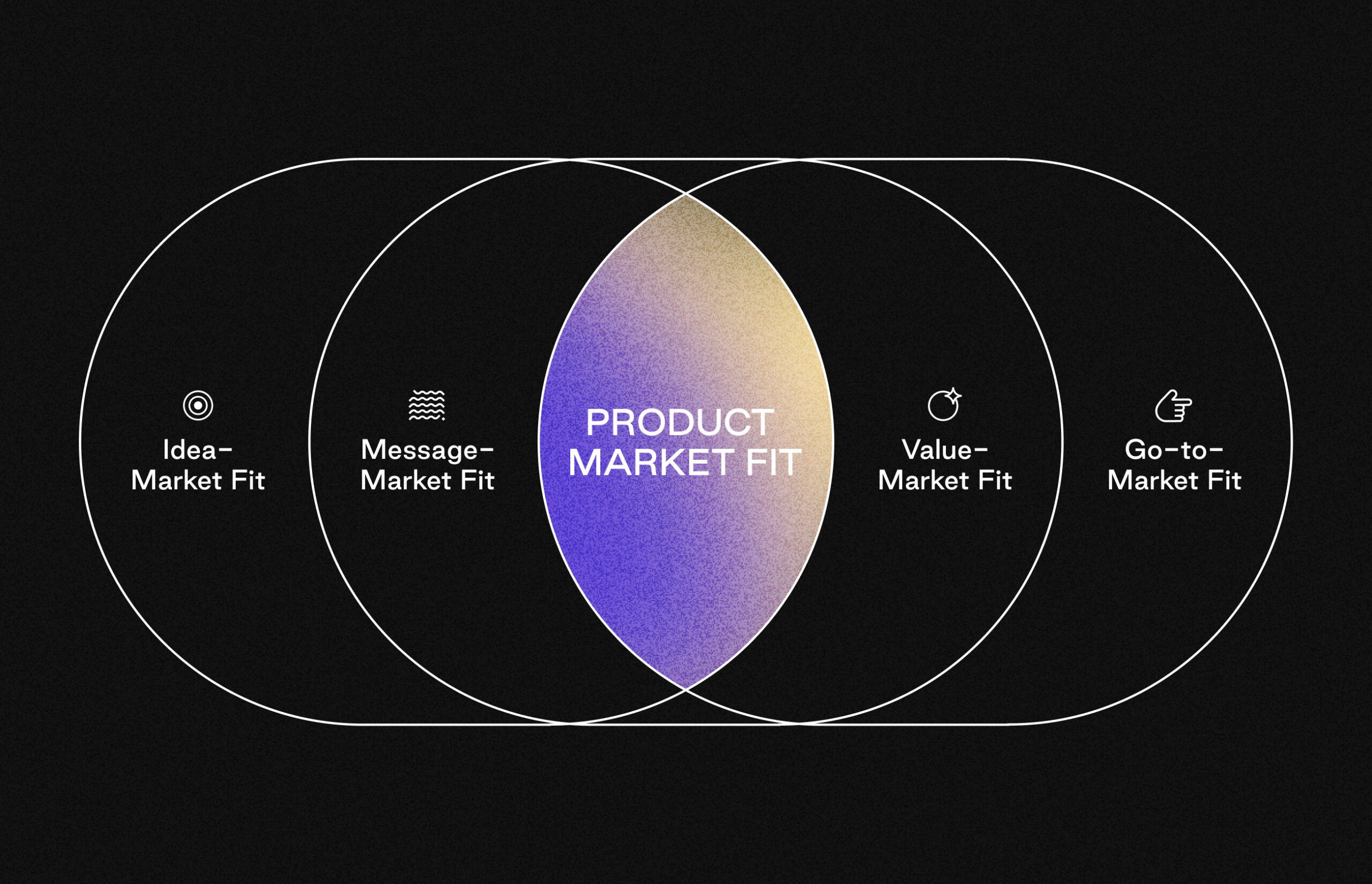
Buyer , User , Startups — 07.11.2023
The Founder’s Guide to Product Market Fit
Katie Lukes, VP, Product Strategy & Research

Reaching product market fit (PMF) is often treated as the Holy Grail, signifying perfect alignment between your solution and target market. But for many founders, product market fit feels confusing, mysterious and ambiguous. And it is ambiguous: everyone has a different opinion on the metrics that determine if you’ve reached it, and it can mean different things at each stage of your company. So how is a founder supposed to know if they’re on the right track? What evidence can they gather that tells them their product is hitting its stride?
While there are many competing ways to answer these questions, there are also ways to break them down to some core component parts to diagnose where you may be having problems. In this article, we’ll demystify PMF and provide a comprehensive framework that outlines different stages and metrics to help you gauge your product’s alignment to the market.
What is Product Market Fit?
PMF is intended to be a metric that helps founders and investors estimate their distance from scalable, repeatable success. There are a few lucky products that achieve it quickly, but for most founders, there is a “messy middle” that requires pivots and changes before they start to see traction. Navigating those changes is difficult and frustrating, and we’re often asked, “How can I tell if what I’m doing is working?”
Contrary to the way it’s typically discussed, PMF is not a clear list of binary metrics that you either hit or miss. PMF is an umbrella term that encompasses a number of factors of success. These range from the basic (is there a problem I’m solving?) to the more complex (can my buyers purchase the way I’m selling?).
To demystify this, we’ve broken down PMF into four manageable stages that help you accurately measure progress and gauge success.

Product market fit is comprised of:
- Idea-Market Fit. Does the product solve a problem that this market will pay for?
- Message-Market Fit. Does the way I describe the problem and solution resonate with this market?
- Value-Market Fit. Does the product meet customer needs enough that they will continue to use it?
- Go-to-Market Fit. Am I selling this solution in the way my buyers can buy?

Idea-Market Fit
The first question in gauging whether your product fits your target market is: Am I solving a painful problem for these target buyers and users? The best practice is to conduct product discovery activities early to establish this before product development and go-to-market. However, some founders start with a promising technology or solution rather than a market, and when they struggle to sell, they find they need to hone in on a specific problem for a specific market.
To determine whether you have idea-market fit, the first step is discovery research to learn if your hypothesized market feels the pain you’re trying to solve. Gather feedback through interviews, focus groups, or observational studies. If you’re looking at multiple markets, talk to all of them and weigh the relative “pain” of the problem you’re solving. If needed, you can then use what you’ve learned to conduct quantitative research through surveys to help gauge how painful the problem is.
There are also lighter weight experiments you can run to determine if your idea has traction. For some types of products, you can try manually solving your users’ problems without a fully developed product, sometimes referred to as a “Wizard of Oz” solution. This will give you a sense of whether this is a problem a customer would be willing to pay to have solved.
You can also conduct “fake door” experiments where you publish Google Ads, sign up pages, or webinars to assess interest and willingness to engage with your solution. Be warned, though, that since users must be drawn to your message in your ad or website, these tests are also a measure of how well your messaging resonates with your prospective customers, which we address in the next section.
Questions to ask:
- Have I identified a problem that this market will pay to solve?
- Have I narrowed my market to be specific enough for my product to resonate?
- Have I identified the right personas within the market to serve as user and buyer?
How to measure:
- Discovery Research: Does the market identify this as a problem?
- Quantitative Research (Survey): How much of the market identifies this as a problem?
- Wizard of Oz experiments (manually solve problems)
- Fake Door experiments (Google Ads, sign-up pages, webinars, etc.)
What to tweak:
- Target market definition
- Personas targeted
- Ideated features/value
- Prioritization of problems/outcomes

Message-Market Fit
Regardless of how compelling your solution is, you must effectively communicate its value to resonate with your target market. You need to convey what it does, who it serves, and why they should care. Achieving message-market fit means crafting the right positioning and messaging to capture the attention and interest of the right buyers.
Metrics such as sign-ups, site traffic and conversion rates can provide insights into the effectiveness of your messaging. High conversion rates indicate customers take you seriously and are willing to take the next steps toward engagement.
To fine-tune your message-market fit, you may need to adjust your positioning, messaging, or branding, and you may need to invest in sales and buyer enablement strategies. Sales enablement refers to how you equip your sales team to communicate your product’s value, and buyer enablement refers to how you equip your buyers to educate themselves. This iterative process allows you to refine your approach and align your strategy with the needs and preferences of your buyers.
Questions to ask:
- Have I positioned this product with the market to speak to their needs?
- Does the language I use resonate with this market?
- Am I being specific to the needs of a focused target market?
- Does my brand convey the right message to this market?
How to measure:
- Sign-ups
- Site traffic, bounces
- Sales conversation resonance
- Conversions
- For PLG: activation, conversion through product or site
What to tweak:
- Positioning
- Messaging
- Brand
- Sales enablement
- Buyer enablement

Value-Market Fit
If you’re solving problems for the right market (idea-market fit) and drawing them in with the right message (message-market fit), you then need to ensure that the solution you’ve designed has value for this market: it works for them in their context, they understand how to use it, and the solution helps them meet their goals.
In early stages, to ensure that you are designing to fit your market, use conversations with users or potential users to understand their needs, goals, and workflow. When you have product designs, even in early wireframe stages, use validation research conversations to gauge whether you have hit a baseline of usability and workflow match.
Once you have users in your product, behavior metrics and subjective metrics can give you indicators to whether your product is meeting user expectations. Measure behavior with milestone (North Star) metrics, churn rates, renewals, and engagement metrics like daily active users (DAUs) to gain valuable insights into customer adoption and continued usage. Subjective metrics measure feelings about your product and include measures like Net Promoter Score (NPS) and Sean Ellis’ customer survey question “How disappointed would you be if you could no longer use this product?”
If you find the metrics for value-market fit are not where you want them to be, talk to your users to find out where the disconnect between their needs and the product occurs for them. You can also use in-app metrics to measure usage of various features or track workflow. These will reveal any gaps between your assumptions and actual user behavior. Continuously refine the user experience based on that feedback to achieve value-market fit faster.
Questions to ask:
- Are my users achieving the outcomes I’ve intended for them to achieve?
- Is the value strong enough that they return and/or tell others?
- Does the way I’ve designed this product fit with users’ workflows and mental models?
How to measure:
- Behavior metrics:
- Milestone (North Star) metrics
- Churn and renewal rates
- Daily active users
- Sharing or referrals
- Subjective metrics:
- NPS
- “How disappointed would you be…?”
What to tweak:
- Information architecture
- Workflow
- Product design
- Prioritization of features

Go-to-Market Fit
Even with a great product and a strong value proposition, your go-to-market strategy can make or break your success. Go-to-market fit means aligning your sales and marketing approach with the preferences and buying behavior of your target market.
For example, if your target market is small-medium businesses that need to move quickly, but your go-to-market strategy is more geared toward how enterprises buy, with drawn out sales activities, long-term contracts, and high-priced packages, your go-to-market activities are not likely to match with small-medium business needs, such as speed of purchase, try-before-you-buy, subscription packages, and entry-level pricing.
Questions to ask:
- Do the buying processes of my target market match how I’m selling my product?
- Am I enabling my buyers with the right materials and information to make a purchase?
- Have I packaged and priced my product in a way that makes it easy for a buyer to engage?
How to measure:
- Conversion rates
- Customer acquisition cost
- Repeatable sales success
What to tweak:
- Sales strategy
- Packaging and pricing
- Product-led growth features such as trials and self-guided demos and tours
- Sales and buyer enablement
Product market fit as an overall measure of startup traction is more important than ever because founders are being held accountable to prove they are reaching measurable success. Once a founder has reached it, it’s easy to refer to product market fit as a single measure. But on the way to success, founders need an easier way to diagnose their issues and discover how to solve them. The component categories of idea-market fit, message-market fit, value-market fit, and go-to-market fit demystify product market fit and make it easier to map out the steps to achieve success.
Find out how our product experts can help you build the right product and go-to-market.

